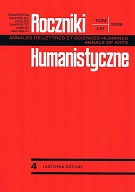Archaizacja i modernizacja. Przemiany stylowe dekoracji sklepiennych na przykładzie kościoła i klasztoru ss. Brygidek w Lublinie
Archaisation and Modernisation. Transformations in the Style of Ceiling Decorations as Instanced in the Bridgettines’ Church
Author(s): Michał KurzejSubject(s): Architecture
Published by: Towarzystwo Naukowe KUL & Katolicki Uniwersytet Lubelski Jana Pawła II
Keywords: archaisation; modernisation; stucco; vault; Bridgettines; post-gothic
Summary/Abstract: Three stages of stucco decoration of the Bridgettines’ Lublin church are clearly Picture by the transformations in the sphere of stucco vault decorations. They correspond to the three widely spread stylistic tendencies: a recurrence to gothic, mannerism and baroque that interpenetrate in the Polish art of the first half of the seventeenth century. The post-gothic decorations of ails’ ceilings were made at the end of the sixteen century. Together with the gable erected then they may be interpreted as an example of conscious the archaisation of architecture, highlighting the medieval genesis of the order. The most proximate analogy for this decoration is found in the vaults of the Augustinians church in Kras´nik. The archaising forms are also in the church in Czemierniki, erected from the foundation of the Firlej family, whose members belonged to the main protectors of Lublin Bridgettines. The first state of modern stuccoes, composed of battens and plaques, was made by Jan Wolff, who decorated the vaults of the two rooms in the monastery and its small church in Czerniejów. The fact that Wolff was employed means that the fashion to correspond to gothic architecture was dying. An expression of this tendency was the church in Rohatyn transformed by Wolff. Its last gothic stage fell on ca. 1600. The stuccoes in the church’s presbytery consist of batten divisions made by Wolff, the figural and ornamental decoration made later, in terms of its style, most probably under the influence of the moulding in the Olelkowicz family’s chapel. It is likely that being influenced by this work Wolff’s mouldings were supplemented by another artist.
Journal: Roczniki Humanistyczne
- Issue Year: 54/2006
- Issue No: 04
- Page Range: 147-187
- Page Count: 41
- Language: Polish

